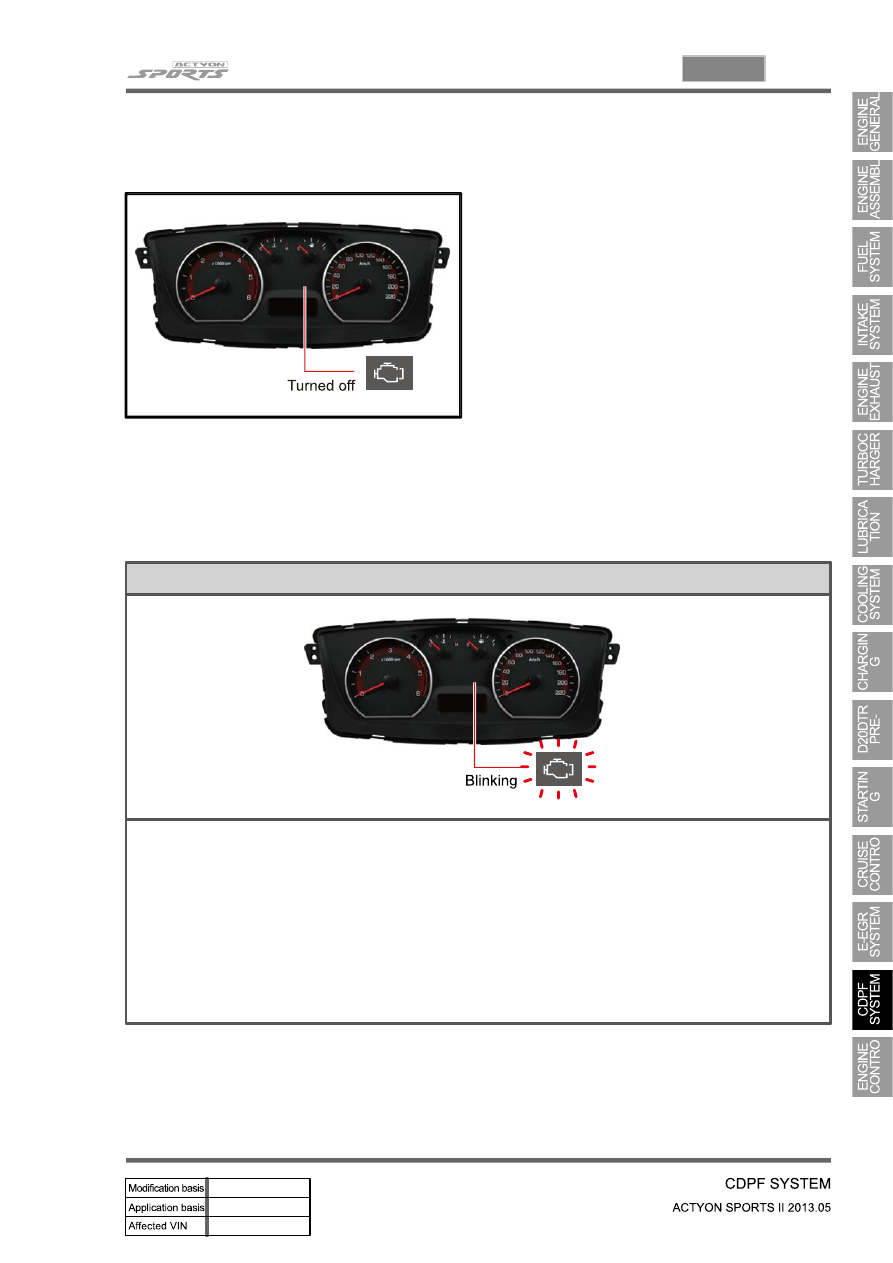SsangYong Actyon Sports II. Manual — part 48

14-5
2412-02
The CDPF system enters the regeneration mode
when the driving distance becomes approx. 600
to 1,200 km (may differ by the driving condition
and driving style). Then, the engine ECU
performs the CDPF regeneration operation.
However, the driver is not informed with this
operation by any engine warning lamp or vehicle
signal, so he/she may not detect this operation.
The control logic at the post-injection dur-ing the
regeneration process is to increase the fuel
injection volume and control the intake air volume
(by the throttle body) in order to increase the
temperature of the exhaust gas. The driver may
not feel any particular difference from the vehicle.
Overload of CDPF (warning lamp blinking)
2) Warning Lamp Related to CDPF
CDPF regeneration process (warning lamp NOT illuminated)
▶
If the CDPF cannot reach the regeneration temperature due to low speed driving or other reason
during the regeneration process, the soot is continuously accumulated in the CDPF. When this
condition continues and the CDPF is overloaded with soot, the engine warning lamp blinks to inform
this situation to the driver.
In order to solve this problem, drive the vehicle at a speed of approx. 80 km/h for 15 to 20 minutes to
perform the CDPF regeneration process.
If the engine warning lamp on the instrument cluster blinks, the CDPF is overloaded. In this case,
perform the step 2.
1.
2.
3.

14-6
Excessive overload of CDPF (warning lamp illuminated)
If the vehicle is driven at a speed of 5 to 10 km/h for an extended period of time, the soot
accumulated in the CDPF cannot be burned as the CDPF cannot reach the regeneration
temperature. Then, an excessive amount of soot can be accumulated in the CDPF.
This case is much worse than the simple over-load of the CDPF. To inform this to the driver, the
engine warning lamp comes on and the engine power is decreased to protect the system.
To solve this problem, blow soot between the engine and exhaust system several times and erase
the related DTC. Then, check if the same DTC is regenerated again. If so, check the DTC related to
the differential pressure sensor.
1.
2.
3.

14-7
2412-02
1. OVERVIEW
The low emission vehicle is being sold increasingly in the market as a countermeasure for complying
with the environment regulations such as a special act on Seoul metropolitan air quality improvement
and for reducing the PM (Particulate Material) from the diesel-powered vehicle. For the CDPF system,
the DOC (two-way catalytic converter or catalytic combustion system) fitted to the conventional diesel
engine has the high purification rate for HC or CO but not have a high reduction rate for the PM. For this
reason, a necessity has been raised in order to consider a countermeasure to reduce the PM since the
existing DOC can't meet the regulation, which is getting tighter.
This results in a development of the CDPF (Catalyst & Diesel Particulate Filter) that is combination of the
existing DOC (Diesel Oxydation Catalyst) and DPF (Diesel Particulate Filter). While the DOC converts
the CO and HC into the CO2 and H2O - unharmful to human body - using a oxidation reaction, the DPF
collects the PF (Particulate Material) for regeneration of it. However, each of these devices can only
reduce a part of the exhaust gas. This evoked the necessity of the CDPF with both features. The DOC
capacity is more on the manual transmission than the automatic transmission.
DPF(Diesel Particulate Filter)
▶
DOC(Diesel Oxidation Catalyst)
▶
It is called as a oxidation catalyst, which purifies CO and HC in exhaust gas. The three-way catalyst is
used for the gasoline vehicle. But, the diesel engine oxidates CO and HC excepting NOx into H2O and
CO2 in order to purify the exhaust gas since the exhaust gas has a rich oxygen at all times.
It consists of mainly the aluminum and titanium and there is a porous thin film, which emits the exhaust
gas but does not emit the PM in it. It emits the exhaust gas generated during combustion and filters the
PM which is a byproduct of combustion to burn it when a certain amount of it is collected in the filter.
When a certain amount of the PM builds up, exposure to high exhaust gas causes carbon, the
fundamental ingredient in PM, to burn and release into the atmosphere in form of CO2.

14-8

Нет комментариевНе стесняйтесь поделиться с нами вашим ценным мнением.
Текст